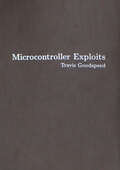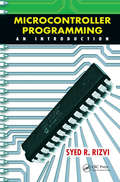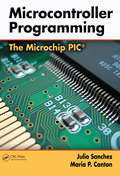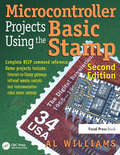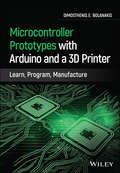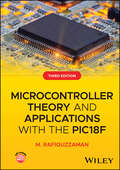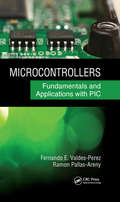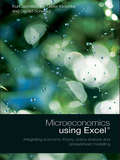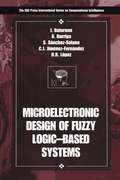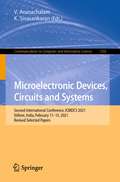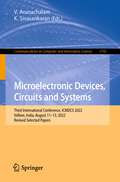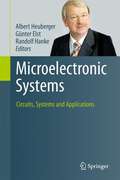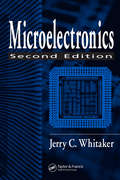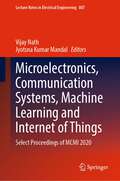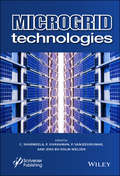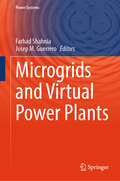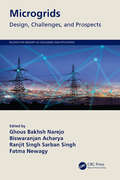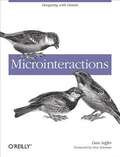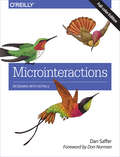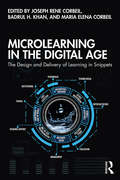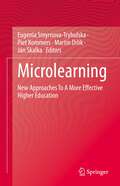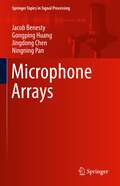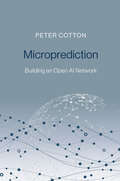- Table View
- List View
Microcontroller Exploits
by Travis GoodspeedMicrocontroller Exploits is a deep dive into advanced hardware hacking with detailed examples of real-world techniques and a comprehensive survey of vulnerabilities.In this advanced guide to hardware hacking, you'll learn how to read the software out of single chip computers, especially when they are configured not to allow the firmware to be extracted. This book documents a very wide variety of microchip hacking techniques; it's not a beginner's first introduction.You'll start off by exploring detailed techniques for hacking real-world chips, such as how the STM32F0 allows for one word to be dumped after every reset. You'll see how the STM32F1&’s exception handling can slowly leak the firmware out over an hour, and how the Texas Instruments MSP430 firmware can be extracted by a camera flash.For each exploit, you'll learn how to reproduce the results, dumping a chip in your own lab.In the second half of the book you'll find an encyclopedic survey of vulnerabilities, indexed and cross referenced for use in practicing hardware security.
Microcontroller Programming: An Introduction
by Syed R. RizviMicrocontroller Programming: An Introduction is a comprehensive one-stop resource that covers the concepts, principles, solution development, and associated techniques involved in microcontroller-based systems. Focusing on the elements and features of the popular and powerful Motorola 68HC11 microcontroller IC as a representative example, this book
Microcontroller Programming: The Microchip PIC
by Julio Sanchez Maria P. CantonFrom cell phones and television remote controls to automobile engines and spacecraft, microcontrollers are everywhere. Programming these prolific devices is a much more involved and integrated task than it is for general-purpose microprocessors; microcontroller programmers must be fluent in application development, systems programming, and I/O operation as well as memory management and system timing. Using the popular and pervasive mid-range 8-bit Microchip PIC® as an archetype, Microcontroller Programming offers a self-contained presentation of the multidisciplinary tools needed to design and implement modern embedded systems and microcontrollers. The authors begin with basic electronics, number systems, and data concepts followed by digital logic, arithmetic, conversions, circuits, and circuit components to build a firm background in the computer science and electronics fundamentals involved in programming microcontrollers.For the remainder of the book, they focus on PIC architecture and programming tools and work systematically through programming various functions, modules, and devices. Helpful appendices supply the full mid-range PIC instruction set as well as additional programming solutions, a guide to resistor color codes, and a concise method for building custom circuit boards.Providing just the right mix of theory and practical guidance, Microcontroller Programming: The Microchip PIC® is the ideal tool for any amateur or professional designing and implementing stand-alone systems for a wide variety of applications.
Microcontroller Projects Using the Basic Stamp
by Al WilliamsComplete BS2P command reference Demo projects include: * Internet-to-Stamp gateways * Infrared remote controls * Test instrumentation * Robot motor controls Want to build an electronic game, a robot, or an automated manufacturing process? A
Microcontroller Prototypes with Arduino and a 3D Printer: Learn, Program, Manufacture
by Dimosthenis E. BolanakisDiscover a complete treatment of microcomputer programming and application development with Arduino and 3D printers Microcontroller Prototypes with Arduino and a 3D Printer: Learn, Program, Manufacture delivers a comprehensive guide to learning microcontrollers that’s perfectly suited to educators, researchers, and manufacturers. The book provides readers with a seasoned expert’s perspective on the process of microcomputer programming and application development. Carefully designed and written example code and explanatory figures accompany the text, helping the reader fully understand and retain the concepts described within. The book focuses on demonstrating how to craft creative and innovative solutions in embedded systems design by providing practical and illustrative methods and examples. An accompanying website includes functioning and tested source code and learning exercises and the book relies on freeware development tools for the creation of firmware and software code, 3D printed enclosures, and debugging. It allows the reader to work with modern sensors and collect sensor data to a host PC for offline analysis. Readers will also benefit from the inclusion of: A thorough introduction to the art of embedded computers, including their interdisciplinarity, TPACK analysis, and the impact of microcontroller technology on the maker industry An exploration of embedded programming with Arduino, including number representation and special-function codes and C common language reference A discussion of hardware interfaces with the outside world, including digital pin interface, analog pin interface, UART serial interface, I2C, and SPI A treatment of sensors and data acquisition, including environmental measurements with Arduino Uno, orientation and motion detection with Teensy, gesture recognition with TinyZero, and color sensing with Micro:bit A variety of supplementary resources – including source codes and examples - hosted on an accompanying website to be maintained by the author: www.mikroct.com. Perfect for researchers and undergraduate students in electrical and electronic engineering or computer engineering, Microcontroller Prototypes with Arduino and a 3D Printer: Learn, Program, Manufacture will also earn a place in the libraries of hardware engineers, embedded system designers, system engineers, and electronic engineers.
Microcontroller Theory and Applications with the PIC18F
by M. RafiquzzamanStraightforward and comprehensive textbook on programming and interfacing techniques for the PIC18F4321 microcontroller, supported by hundreds of illustrations throughout Microcontroller Theory and Applications with the PIC18F presents core information on the theory of microcontrollers and the fundamental concepts of assembly and C language programming and interfacing techniques associated with the Microchip's PIC18F4321 microcontroller. Characteristics and principles common to typical microcontrollers are emphasized, and basic microcontroller interfacing techniques are demonstrated via examples using the simplest possible devices such as switches, LEDs, Seven-Segment Displays, and the hexadecimal keyboard. In addition, interfacing the PIC18F with other devices such as LCD displays, ADC, DAC is also included. Furthermore, topics such as CCP (Capture, Compare, PWM) and Serial I/O using assembly and C languages along with simple examples are also provided. Information on the design of the PIC18F-based digital DC voltmeter and interfacing the PIC18F with PWM (Pulse Width Modulation) mode to a DC motor using both assembly and C languages is provided. Finally, PIC18F Serial I/O examples using both SPI and I2C modes are also included. All these examples are illustrated by means of successful implementations in the laboratory. Building on the success of previous editions, this Third Edition has been extensively revised to include enhanced clarity in each chapter and additional illustrations, end-of-chapter problems, and examples. Certain concepts such as stack, bank-memory, programmed I/O, interrupt I/O, and CCP have been rewritten to better relate them to the PIC18F. Details on the MPLABX assembler/debugger and XC8 C-Compiler are now included as well. Microcontroller Theory and Applications with the PIC18F includes information on: Microcontroller data types, unsigned and signed binary numbers and ASCII code, unpacked and packed binary-coded-decimal numbers, and the evolution of the microcontroller Provides guidelines on how to choose the right language (Assembly or C ) for specific applications PIC18F architecture and addressing modes, covering register architecture, memory organization, and program and data memories Programming PIC18F programmed I/O, interrupt I/O, and interfacing PIC18F4321 to a hexadecimal keyboard and a seven-segment display ADC, DAC, CCP, and Serial I/O interfacing techniques Microcontroller Theory and Applications with the PIC18F is an essential learning resource for students in related programs of study seeking information on basic concepts relating to a specific and simple microcontroller such as the PIC18F in an organized and simplified manner.
Microcontrollers: Fundamentals and Applications with PIC
by Fernando E. Valdes-Perez Ramon Pallas-ArenyMicrocontrollers exist in a wide variety of models with varying structures and numerous application opportunities. Despite this diversity, it is possible to find consistencies in the architecture of most microcontrollers. Microcontrollers: Fundamentals and Applications with PIC focuses on these common elements to describe the fundamentals of microcontroller design and programming. Using clear, concise language and a top-bottom approach, the book describes the parts that make up a microcontroller, how they work, and how they interact with each other. It also explains how to program medium-end PICs using assembler language. Examines analog as well as digital signals This volume describes the structure and resources of general microcontrollers as well as PIC microcontrollers, with a special focus on medium-end devices. The authors discuss memory organization and structure, and the assembler language used for programming medium-end PIC microcontrollers. They also explore how microcontrollers can acquire, process, and generate digital signals, explaining available techniques to deal with parallel input or output, peripherals, resources for real-time use, interrupts, and the specific characteristics of serial data interfaces in PIC microcontrollers. Finally, the book describes the acquisition and generation of analog signals either using resources inside the chip or by connecting peripheral circuits. Provides hands-on clarification Using practical examples and applications to supplement each topic, this volume provides the tools to thoroughly grasp the architecture and programming of microcontrollers. It avoids overly specific details so readers are quickly led toward design implementation. After mastering the material in this text, they will understand how to efficiently use PIC microcontrollers in a design process.
Microeconomics using Excel: Integrating Economic Theory, Policy Analysis and Spreadsheet Modelling
by Gerald Schwarz Kurt Jechlitschka Dieter KirschkeUsing Microsoft Excel, the market leading spreadsheet package, this book combines theory with modelling aspects and spreadsheet analysis. Microeconomics Using Excel provides students with the tools with which to better understand microeconomic analysis.It focuses on solving microeconomic problems by integrating economic theory, policy analysis and
Microelectronic Design of Fuzzy Logic-Based Systems (International Series on Computational Intelligence)
by Iluminada Baturone Angel Barriga Carlos Jimenez-Fernandez Diego R. Lopez Santiago Sanchez-SolanoFuzzy logic has virtually exploded over the landscape of emerging technologies, becoming an integral part of myriad applications and a standard tool for engineers. Until recently, most of the attention and applications have centered on fuzzy systems implemented in software. But these systems are limited. Problems that require real-time operation, low area, or low power consumption demand hardware designed to the fuzzy paradigm - and engineers with the background and skills to design it.Microelectronic Design of Fuzzy Logic-Based Systems offers low-cost answers to issues that software cannot resolve. From the theoretical, architectural, and technological foundation to design tools and applications, it serves as your guide to effective hardware realizations of fuzzy logic.Review fuzzy logic theory and the basic issues of fuzzy sets, operators, and inference mechanisms Explore the trade-offs between efficient theoretical behavior and practical hardware realizations Discover the properties of the possible microelectronic realizations of fuzzy systems - conventional processors, fuzzy coprocessors, and fuzzy chips Investigate the design of fuzzy chips that implement the whole fuzzy inference method into silicon Analyze analog, digital, and mixed-signal techniques Reduce your design effort for fuzzy systems with CAD tools - learn the requirements they should meet and survey current environments. Put it all together - see examples and case studies illustrating how all of this is used to solve particular problems related to control and neuro-fuzzy applications
Microelectronic Devices, Circuits and Systems: Second International Conference, ICMDCS 2021, Vellore, India, February 11-13, 2021, Revised Selected Papers (Communications in Computer and Information Science #1392)
by V. Arunachalam K. SivasankaranThis book constitutes selected papers from the Second International Conference on Microelectronic Devices, Circuits and Systems, ICMDCS 2021, held in Vellore, India, in February 2021. The 32 full papers and 6 short papers presented were thoroughly reviewed and selected from 103 submissions. They are organized in the topical sections on digital design for signal, image and video processing; VLSI testing and verification; emerging technologies and IoT; nano-scale modelling and process technology device; analog and mixed signal design; communication technologies and circuits; technology and modelling for micro electronic devices; electronics for green technology.
Microelectronic Devices, Circuits and Systems: Third International Conference, ICMDCS 2022, Vellore, India, August 11–13, 2022, Revised Selected Papers (Communications in Computer and Information Science #1743)
by V. Arunachalam K. SivasankaranThis book constitutes the proceedings of the Third International Conference on Microelectronic Devices, Circuits and Systems, ICMDCS 2022, was held in Vellore, India, in August 2022.The 9 full papers and 5 short paper presented in this volume were carefully reviewed and selected from 84 submissions. The papers are organized in the following topical sections: System Level Design; Digital Design; Analog, Mixed-Signal and RF Design; and Emerging Technologies.
Microelectronic Systems
by Albert Heuberger Randolf Hanke Günter Elst Karlheinz Kirsch Janina HeppnerThis book is dedicated to Prof. Dr. Heinz Gerhäuser on the occasion of his retirement both from the position of Executive Director of the Fraunhofer Institute for Integrated Circuits IIS and from the Endowed Chair of Information Technologies with a Focus on Communication Electronics (LIKE) at the Friedrich-Alexander-Universität Erlangen-Nürnberg. Heinz Gerhäuser's vision and entrepreneurial spirit have made the Fraunhofer IIS one of the most successful and renowned German research institutions. He has been Director of the Fraunhofer IIS since 1993, and under his leadership it has grown to become the largest of Germany's 60 Fraunhofer Institutes, a position it retains to this day, currently employing over 730 staff. Likely his most important scientific as well as application-related contribution was his pivotal role in the development of the mp3 format, which would later become a worldwide success. The contributions to this Festschrift were written by both Fraunhofer IIS staff and external project team members in appreciation of Prof. Dr. Gerhäuser's lifetime academic achievements and his inspiring leadership at the Fraunhofer IIS. The papers reflect the broad spectrum of the institute's research activities and are grouped into sections on circuits, information systems, visual computing, and audio and multimedia. They provide academic and industrial researchers in fields like signal processing, sensor networks, microelectronics, and integrated circuits with an up-to-date overview of research results that have a huge potential for cutting-edge industrial applications.
Microelectronic Systems: Circuits, Systems and Applications
by Karlheinz Kirsch Janina HeppnerThis book is dedicated to Prof. Dr. Heinz Gerhäuser on the occasion of his retirement both from the position of Executive Director of the Fraunhofer Institute for Integrated Circuits IIS and from the Endowed Chair of Information Technologies with a Focus on Communication Electronics (LIKE) at the Friedrich-Alexander-Universität Erlangen-Nürnberg.Heinz Gerhäuser's vision and entrepreneurial spirit have made the Fraunhofer IIS one of the most successful and renowned German research institutions. He has been Director of the Fraunhofer IIS since 1993, and under his leadership it has grown to become the largest of Germany's 60 Fraunhofer Institutes, a position it retains to this day, currently employing over 730 staff. Likely his most important scientific as well as application-related contribution was his pivotal role in the development of the mp3 format, which would later become a worldwide success.The contributions to this Festschrift were written by both Fraunhofer IIS staff and external project team members in appreciation of Prof. Dr. Gerhäuser's lifetime academic achievements and his inspiring leadership at the Fraunhofer IIS. The papers reflect the broad spectrum of the institute's research activities and are grouped into sections on circuits, information systems, visual computing, and audio and multimedia. They provide academic and industrial researchers in fields like signal processing, sensor networks, microelectronics, and integrated circuits with an up-to-date overview of research results that have a huge potential for cutting-edge industrial applications.
Microelectronics (Electronics Handbook Series)
by Jerry C. WhitakerWhen it comes to electronics, demand grows as technology shrinks. From consumer and industrial markets to military and aerospace applications, the call is for more functionality in smaller and smaller devices. Culled from the second edition of the best-selling Electronics Handbook, Microelectronics, Second Edition presents a summary of the current state of microelectronics and its innovative directions.This book focuses on the materials, devices, and applications of microelectronics technology. It details the IC design process and VLSI circuits, including gate arrays, programmable logic devices and arrays, parasitic capacitance, and transmission line delays. Coverage ranges from thermal properties and semiconductor materials to MOSFETs, digital logic families, memory devices, microprocessors, digital-to-analog and analog-to-digital converters, digital filters, and multichip module technology. Expert contributors discuss applications in machine vision, ad hoc networks, printing technologies, and data and optical storage systems. The book also includes defining terms, references, and suggestions for further reading. This edition features two new sections on fundamental properties and semiconductor devices.With updated material and references in every chapter, Microelectronics, Second Edition is an essential reference for work with microelectronics, electronics, circuits, systems, semiconductors, logic design, and microprocessors.
Microelectronics, Communication Systems, Machine Learning and Internet of Things: Select Proceedings of MCMI 2020 (Lecture Notes in Electrical Engineering #887)
by Jyotsna Kumar Mandal Vijay NathThis volume presents peer-reviewed papers of the First International Conference on Microelectronics, Communication Systems, Machine Learning, and the Internet of Things (MCMI-2020). This book discusses recent trends in technology and advancement in microelectronics, nano-electronics, VLSI design, IC technologies, wireless communications, optical communications, SoC, advanced instrumentations, signal processing, internet of things, machine learning, image processing, green energy, hybrid vehicles, weather forecasting, cloud computing, renewable energy, CMOS sensors, actuators, RFID, transducers, real-time embedded system, sensor network and applications, EDA design tools and techniques, fuzzy logic & artificial intelligence, high-performance computer architecture, AI-based robotics & applications, brain-computer interface, deep learning, advanced operating systems, supply chain development & monitoring, physical systems design, ICT applications, e-farming, information security, etc. It includes original papers based on theoretical, practical, experimental, simulations, development, application, measurement, and testing. The applications and solutions discussed in the book will serve as good reference material for young scholars, researchers, and academics.
Microgrid Technologies
by P. Sanjeevikumar Jens Bo Holm-Nielsen P. Sivaraman C. SharmeelaMicrogrid technology is an emerging area, and it has numerous advantages over the conventional power grid. A microgrid is defined as Distributed Energy Resources (DER) and interconnected loads with clearly defined electrical boundaries that act as a single controllable entity concerning the grid. Microgrid technology enables the connection and disconnection of the system from the grid. That is, the microgrid can operate both in grid-connected and islanded modes of operation. Microgrid technologies are an important part of the evolving landscape of energy and power systems. Many aspects of microgrids are discussed in this volume, including, in the early chapters of the book, the various types of energy storage systems, power and energy management for microgrids, power electronics interface for AC & DC microgrids, battery management systems for microgrid applications, power system analysis for microgrids, and many others. The middle section of the book presents the power quality problems in microgrid systems and its mitigations, gives an overview of various power quality problems and its solutions, describes the PSO algorithm based UPQC controller for power quality enhancement, describes the power quality enhancement and grid support through a solar energy conversion system, presents the fuzzy logic-based power quality assessments, and covers various power quality indices. The final chapters in the book present the recent advancements in the microgrids, applications of Internet of Things (IoT) for microgrids, the application of artificial intelligent techniques, modeling of green energy smart meter for microgrids, communication networks for microgrids, and other aspects of microgrid technologies. Valuable as a learning tool for beginners in this area as well as a daily reference for engineers and scientists working in the area of microgrids, this is a must-have for any library.
Microgrids and Virtual Power Plants (Power Systems)
by Farhad Shahnia Josep M. GuerreroThis book highlights recent research advancements in the area of microgrids and virtual power plants. Microgrids and virtual power plants are the future of power generation and delivery systems, and there has been significant research interest in this area over the past decade. The key emphasis of this book is on the various modelling, analysis, and management aspects of microgrids and virtual power networks. Interesting topics such as their planning, operation, and technology accommodation are presented in detail. The chapters in the book discuss existing and new modelling approaches, control and management methods, as well as their structures, planning, monitoring, protection, and coordination. This book introduces and covers these topics in a comprehensive and coherent way for professionals and researchers.
Microgrids: Design, Challenges, and Prospects (Big Data for Industry 4.0)
by Ghous Bakhsh Narejo Biswaranjan Acharya Ranjit Singh Sarban Singh Fatma NewagyThe book addresses the needs of researchers on the fundamentals as well as more advanced knowledge on microgrids and their evolution. This book covers newly emerging trends in fields such as Computer Science, Energy, Electrical Engineering, and Electronics and brings the reader up-to-date on the new emerging fields that play an important role in the power infrastructure. This book provides knowledge on decision making for newly evolving trends in microgrid design. It discusses techniques on how to improve the existing power quality and reduce load shedding and power imbalances. The book presents the emerging fields that now play an important role in microgrid design such as Data Science, Machine Learning, AI, and IT. The readership includes researchers, academia, practicing engineers, consumers, power companies and policy makers located across the globe.
Microgrids: Theory and Practice (IEEE Press Series on Power and Energy Systems)
by Peng ZhangMicrogrids Understand microgrids and networked microgrid systems Microgrids are interconnected groups of energy sources that operate together, capable of connecting with a larger grid or operating independently as needed and network conditions require. They can be valuable sources of energy for geographically circumscribed areas with highly targeted energy needs, and for remote or rural areas where continuous connection with a larger grid is difficult. Microgrids’ controllability makes them especially effective at incorporating renewable energy sources. Microgrids: Theory and Practice introduces readers to the analysis, design, and operation of microgrids and larger networked systems that integrate them. It brings to bear both cutting-edge research into microgrid technology and years of industry experience in designing and operating microgrids. Its discussions of core subjects such as microgrid modeling, control, and optimization make it an essential short treatment, valuable for both academic and industrial study. Readers will acquire the skills needed to address existing problems and meet new ones as this crucial area of power engineering develops. Microgrids: Theory and Practice also features: Incorporation of new cyber-physical system technologies for enabling microgrids as resiliency resources Theoretical treatment of a wide range of subjects including smart programmable microgrids, distributed and asynchronous optimization for microgrid dispatch, and AI-assisted microgrid protection Practical discussion of real-time microgrids simulations, hybrid microgrid design, transition to renewable microgrid networks, and more Microgrids: Theory and Practice is ideal as a textbook for graduate and advanced undergraduate courses in power engineering programs, and a valuable reference for power industry professionals looking to address the challenges posed by microgrids in their work.
Microinteractions
by Dan SafferIt's the little things that turn a good digital product into a great one. With this practical book, you'll learn how to design effective microinteractions: the small details that exist inside and around features. How can users change a setting? How do they turn on mute, or know they have a new email message? Through vivid, real-world examples from today's devices and applications, author Dan Saffer walks you through a microinteraction's essential parts, then shows you how to use them in a mobile app, a web widget, and an appliance. You'll quickly discover how microinteractions can change a product from one that's tolerated into one that's treasured. Explore a microinteraction's structure: triggers, rules, feedback, modes, and loops Learn the types of triggers that initiate a microinteraction Create simple rules that define how your microinteraction can be used Help users understand the rules with feedback, using graphics, sounds, and vibrations Use modes to let users set preferences or modify a microinteraction Extend a microinteraction's life with loops, such as "Get data every 30 seconds"
Microinteractions: Designing with Details
by Dan SafferIt’s the little things that turn a good digital product into a great one. With this full color practical book, you’ll learn how to design effective microinteractions: the small details that exist inside and around features. How can users change a setting? How do they turn on mute, or know they have a new email message?Through vivid, real-world examples from today’s devices and applications, author Dan Saffer walks you through a microinteraction’s essential parts, then shows you how to use them in a mobile app, a web widget, and an appliance. You’ll quickly discover how microinteractions can change a product from one that’s tolerated into one that’s treasured.Explore a microinteraction’s structure: triggers, rules, feedback, modes, and loopsLearn the types of triggers that initiate a microinteractionCreate simple rules that define how your microinteraction can be usedHelp users understand the rules with feedback, using graphics, sounds, and vibrationsUse modes to let users set preferences or modify a microinteractionExtend a microinteraction’s life with loops, such as “Get data every 30 seconds”
Microlearning in the Digital Age: The Design and Delivery of Learning in Snippets
by Joseph Rene CorbeilMicrolearning in the Digital Age explores the design and implementation of bite-sized learning and training in technology-enabled environments. Grounded in research-based best practices and a robust, eight-dimensional framework, this book applies the latest developments in mobile learning, social media, and instructional/multimedia design to one of today’s most innovative and accessible content delivery systems. Featuring experts from higher education, information technology, digital gaming, corporate, and other contexts, this comprehensive guide will prepare graduate students, researchers, and professionals of instructional design, e-learning, and distance education to develop engaging, cost-effective microlearning systems.
Microlearning: New Approaches To A More Effective Higher Education
by Piet Kommers Eugenia Smyrnova-Trybulska Martin Drlík Ján SkalkaThis book is about the most significant developments in the field of microlearning in the teaching of programming. In particular, the book covers the creation of content and the use of microlearning activities for automatically evaluating programming assignments. These critical component of microlearning represent a significant contribution both in fulfilling individual project objectives and in improving computer programming education in general. The book is interdisciplinary, examining both computer science and education. Specific topics explored include: development of distance courses, creating microcourses, fostering interdisciplinary knowledge, IT, management, and theoretical, methodological and practical aspects of the implementation of microlearning. Additionally, comprehensive analysis of the scientific literature (monographs, articles, proceedings) on the subject of the project and conducted research is provided.
Microphone Arrays (Springer Topics in Signal Processing #22)
by Jacob Benesty Jingdong Chen Gongping Huang Ningning PanThis book explains the motivation for using microphone arrays as opposed to using a single sensor for sound acquisition. The book then goes on to summarize the most useful ideas, concepts, results, and new algorithms therein. The material presented in this work includes analysis of the advantages of using microphone arrays, including dimensionality reduction to remove the redundancy while preserving the variability of the array signals using the principal component analysis (PCA). The authors also discuss benefits such as beamforming with low-rank approximations, fixed, adaptive, and robust distortionless beamforming, differential beamforming, and a new form of binaural beamforming that takes advantage of both beamforming and human binaural hearing properties to improve speech intelligibility. The book makes the microphone array signal processing theory and applications available in a complete and self-contained text. The authors attempt to explain the main ideas in a clear and rigorous way so that the reader can easily capture the potentials, opportunities, challenges, and limitations of microphone array signal processing. This book is written for those who work on the topics of microphone arrays, noise reduction, speech enhancement, speech communication, and human-machine speech interfaces.
Microprediction: Building an Open AI Network
by Peter CottonHow a web-scale network of autonomous micromanagers can challenge the AI revolution and combat the high cost of quantitative business optimization.The artificial intelligence (AI) revolution is leaving behind small businesses and organizations that cannot afford in-house teams of data scientists. In Microprediction, Peter Cotton examines the repeated quantitative tasks that drive business optimization from the perspectives of economics, statistics, decision making under uncertainty, and privacy concerns. He asks what things currently described as AI are not &“microprediction,&” whether microprediction is an individual or collective activity, and how we can produce and distribute high-quality microprediction at low cost. The world is missing a public utility, he concludes, while companies are missing an important strategic approach that would enable them to benefit—and also give back. In an engaging, colloquial style, Cotton argues that market-inspired &“superminds&” are likely to be very effective compared with other orchestration mechanisms in the domain of microprediction. He presents an ambitious yet practical alternative to the expensive &“artisan&” data science that currently drains money from firms. Challenging the machine learning revolution and exposing a contradiction at its heart, he offers engineers a new liberty: no longer reliant on quantitative experts, they are free to create intelligent applications using general-purpose application programming interfaces (APIs) and libraries. He describes work underway to encourage this approach, one that he says might someday prove to be as valuable to businesses—and society at large—as the internet.
